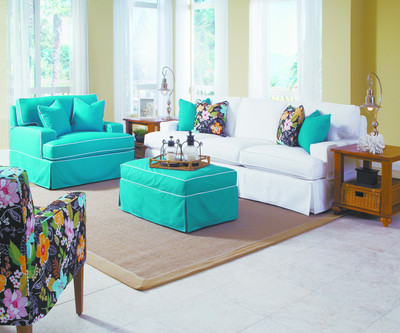Green and Gorgeous

If you had the opportunity to purchase a beautiful, fashionable sofa that perfectly suited your décor and also helped the environment, wouldn’t you?
Stefanie Lucas, chief executive officer of Rowe Furniture, found herself asking that same question and came up with a resounding yes answer.
And so the company debuted Eco Rowe, a small collection of green furniture that uses natural-fiber fabrics, woods from sustainable forests and partially plant-based cushion cores.
It didn’t take long for the company to start hearing rave reviews from consumers. The response was so positive that the company decided to make all of its furniture environmentally friendly.
Today, Rowe uses eco-friendly cushioning that blends down feathers and recycled plastic soda bottles and offers natural fabrics made of cotton, linen, hemp and bamboo. Organic fabrics are available through its Robin Bruce brand.
“We felt as a company that it was our responsibility to do products that are more eco-friendly,” Lucas said.
It’s a philosophy that is gaining momentum in the industry as more and more manufacturers unveil green collections that are good for the environment without sacrificing style or increasing prices.
“I am certain the move towards green design in the home-furnishings industry is not a fad. Consumers are learning more about how to make eco-friendly decisions, and as this new-found knowledge and empowerment trickles down the roots of our society the demand is rising. Making smart choices is never a fad,” said Holly Blalock, creative director for C.R. Laine Furniture of Hickory, N.C.
Blalock said the company also is on Twitter and Facebook, where it encourages consumers to join an open dialogue about eco-friendly upholstery.
“Consumers have become very aware of the importance of buying products that make sense for the environment,” agreed Jeff Cook, president of Broyhill Home Furnishings. “Some consumers may think that to buy green you have to pay a premium or that the quality is substandard, but that’s simply not the case.”
Cook said the Lenoir, N.C.-based company recently introduced four new pieces to its green line that are highly durable and retail from $899 to $999.
“Because all C.R. Laine upholstery is standard with the world-friendly components, consumers do not have to pay anything extra to know that their purchase has made a positive impact on our environment,” Blalock said.
However, for less than $100 for a sofa and $30 for a chair consumers have the option to elevate their environmental commitment by adding a down2earth cushion, which adds a bio-based seat cushion that replaces at least 20 percent of the petroleum-based ingredients with natural, plant-based ingredients such as corn or soy and wraps it in a layer of fiber made of regenerated fibers before inserting it into a 100 percent cotton casing. Also, back cushions and throw pillows are filled with 100 percent post-consumer regenerated fibers that are put into a 100 percent cotton casing.
“Post-consumer regenerated materials pull empty plastic drink bottles out of the waste stream and repurpose them into a new product. Post-consumer regenerated fiber starts as plastic drink bottles that are stripped of labels, washed and chopped up into flakes. These tiny pieces are then melted down and extruded from spinnerets, creating a fluffy fiber that is crimped and used as fiber filling. This saves approximately 500 drink bottles per sofa from going into the landfill,” Blalock said.
But the materials used in the upholstery is only a portion of the environmental equation.
The McLean, Va.-based Rowe, a founding member of Sustainable Furniture Council, changed the way the furniture itself is made. Glues are now water based and recycling programs are in place throughout the factories.
C.R. Laine also switched to water-based finishes that reduce the levels of volatile organic compounds released into the air, established recycling programs and conserves energy by switching off the lights and computers in both the plant and the corporate offices during lunch and nonworking hours. It also established a water conservation policy.
“C.R. Laine is committed to preserving the resources of our world for future generations. It is our goal to minimize the environmental impact of our company through the continual improvement of waste reduction and use of sustainable practices,” Blalock said. “Our efforts were rewarded when, in 2008, C.R. Laine became the first company to achieve the American Home Furnishings Alliance’s Sustainable by Design certification.